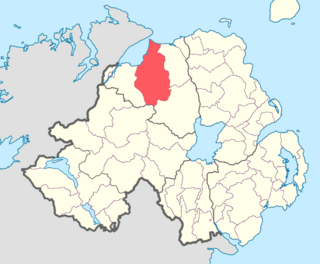Related Research Articles

Uí Fhiachrach Aidhne was a kingdom located in what is now the south of County Galway.

O'Flaherty is an Irish Gaelic clan based most prominently in what is today County Galway. The clan name originated in the 10th century as a derivative of its founder Flaithbheartach mac Eimhin. They descend in the paternal line from the Connachta's Uí Briúin Seóla. They were originally kings of Maigh Seóla and Muintir Murchada and as members of the Uí Briúin were kinsmen of the Ó Conchubhair and Mac Diarmada amongst others. After their king Cathal mac Tigernán lost out to Áed in Gai Bernaig in the 11th century, the family were pushed further west to Iar Connacht, a territory associated with Connemara today. They continued to rule this land until the 16th century. The name has been alternatively rendered into English in various forms, such as Flaherty, Fluharty, Faherty, Laverty, Flaverty, Lahiff, and Flahive.

Meath was a kingdom in Ireland from the 1st to the 12th century AD. Its name means "middle," denoting its location in the middle of the island.
The kingdom of Uí Fháilghe, Uí Failge or Uíbh Fhailí, was a Gaelic-Irish kingdom which existed to 1550, the name of which is preserved in the name of County Offaly, Ireland.
Mac Aodhagáin, is an Irish Gaelic clan of Brehons who were hereditary lawyers - firstly to the Ó Conchobhair Kings of Connacht, and later to the Burkes of Clanricarde.
O'Dempsey's GAA is a Gaelic football club located in the northeast of County Laois, Ireland.
Fland Dá Chongal or Flann Ua Congaile was a king of the Uí Failge, a Laigin people of County Offaly.
Forbassach Ua Congaile was a king of the Uí Failge, a Laigin people of County Offaly.
Cummascach mac Flainn was a king of the Uí Failge, a Laigin people of County Offaly. He was one of the many sons of Fland Dá Chongal, a previous king. He ruled from 755 to 757. He was the first of Fland's sons by Érenach, daughter of Murchad Midi of Uisnech to hold the throne.
Mugrón mac Flainn was a king of the Uí Failge, a Laigin people of County Offaly. He was one of the many sons of Fland Dá Chongal, a previous king. He ruled from 770 to 782. He was the third of Fland's sons by Érenach, daughter of Murchad Midi of Uisnech, to hold the throne.
Óengus mac Mugróin was a king of the Uí Failge, a Laigin people of County Offaly. He was the son of Mugrón mac Flainn, a previous king. He ruled from 783 to 803.
Áed Rón mac Cathail was a king of the Uí Failge, a Laigin people of County Offaly. He was the grandson of Bruidge mac Nath Í, a previous king.

Keenaght is a barony in the mid-northerly third of County Londonderry, Northern Ireland. It connects to the north-Londonderry coastline, and is bordered by four other baronies: Coleraine to the east; Loughinsholin to the south-east; Tirkeeran to the west; and Strabane Upper to the south-west. It was the territory of the Cianachta Glengiven from the 5th century until its takeover in the 12th century by the Ó Cathaín's. The largest settlement in the barony is the town of Limavady.

Tully is a surname of Irish origin, with spelling variations that include Tally, Talley, Tilly, MacTully, MacTilly, MacAtilla, O'Multilly, O'Multully, MacCantully, and Flood. These names are anglicisations of the following Irish names: Ó Taithligh, Ó Maoltuile, Mac Maoltuile, Mac Taichligh, and Mac an Tuile. Mac an Tuile is a corruption of Mac Maoltuile, and has also been anglicised as Flood due to "tuile" in Irish meaning "flood".

O'Driscoll is an Irish surname. It is derived from the Gaelic Ó hEidirsceoil. The O'Driscolls were rulers of the Dáirine sept of the Corcu Loígde until the early modern period; their ancestors were Kings of Munster until the rise of the Eóganachta in the 7th century. At the start of the 13th century, three prominent branches of the family came into existence: O'Driscoll Mor, O'Driscoll Og, and O'Driscoll Beara. The Ó prefix was dropped by many in Ireland during the 17th and 18th centuries. The surname is now most prominent in the Irish counties of Cork and Kerry.
Offaly East is a barony in County Kildare, Ireland.
Terence O'Dempsey, 1st Viscount Clanmalier was an Irish aristocrat.
Donnchad mac Murchada was a King of Leinster from 1098 until 1115 when he died in battle while fighting Domnall Gerrlámhach, the King of Dublin. A near contemporary account by Gerald of Wales, suggests that the King of Dublin lured him to Dublin under false pretence of peace, killed him and then buried him with a dog as an insult.
References
- ↑ Grenham, John (1994). The Little Book of Irish Clans . Dublin, Ireland: John Hinde. p. 18. ISBN 0-7858-0083-2.
- ↑ Reany, P. H.; Wilson, R. M. (1995). A Dictionary of English Surnames (3rd ed.). Oxford University Press. p. 131a.
- ↑ MacLysaght, Edward (1991). The Surnames of Ireland (6th ed.). Dublin: Irish Academic Press. p. 79.
- ↑ Grenham, John. "Irish Surnames". JohnGrenham.com. Retrieved 29 August 2019.
- 1 2 Walsh, Dennis, ed. (2009). "Ireland's History in Maps – Leinster Series: The Tribes of Laigen". County Kilkenny Ireland Genealogy and History. Retrieved 29 August 2019– via Sites.RootsWeb.com.
- ↑ Cairney, C. Thomas (1989). Clans and Families of Ireland and Scotland. Jefferson, North Carolina, United States, and London: McFarland & Company. pp. 78–83. ISBN 0899503624.
- ↑ "Irish surnames". www.johngrenham.com. Retrieved 29 August 2019.
- Matthews, Thomas (1903) Account of the O'Dempseys, Chiefs of Clan Maliere